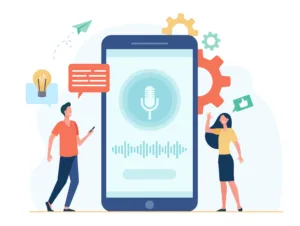When you purchase through links on our site, we may earn an affiliate commission. This doesn’t affect our editorial independence.
Most people type their questions to ChatGPT. But there’s another way. You can actually speak to it now, and it talks back. This isn’t some gimmicky feature either – it genuinely changes how you use the tool. We will show you How to Use Voice Commands on Chatgpt in the article.
Voice mode appeared in the ChatGPT mobile app several months ago. Desktop browsers are getting it too, though not everyone has access yet. The rollout seems random. Some accounts get it immediately, others wait weeks.
Mobile App Setup to use Voice Commands on Chatgpt
Download the official ChatGPT app first. Fake versions exist in app stores, so check the developer name – it should say OpenAI. These knockoff apps often contain malware or steal your data.
Open the app and log in with your OpenAI credentials. New users can create accounts directly in the app. The process takes about two minutes.
Look for a small headphone icon on the main chat screen. Location varies between iOS and Android, but it’s usually near the bottom somewhere. Tap it once.
Your phone will request microphone permissions if this is your first time. Say yes, obviously. Without mic access, voice mode can’t function at all.
The app greets you with a spoken hello. Then you just speak normally. No wake words required.
To exit voice mode, tap the screen or press the headphone icon again. The interface immediately switches back to keyboard input.
Browser Voice Features on ChatGpt
Desktop voice support exists but remains limited. OpenAI controls who gets access and when. There’s no clear pattern – some free accounts have it while some paid subscribers don’t.
If you have browser access, visit chat.openai.com and sign in normally. A microphone symbol appears in the text input area when voice features are enabled for your account.
Browsers need microphone permissions before anything works. Chrome handles this smoothly. Firefox usually cooperates. Safari can be finicky about audio permissions.
Here’s the limitation: browser voice only converts speech to text. ChatGPT responds in writing, not audio. You get half the conversational experience compared to mobile apps.
Speaking Techniques For ChatGpt That Work
Pronunciation matters more than you’d expect. Regional accents sometimes confuse the recognition system. Speaking slightly slower than normal conversation helps accuracy.
Background noise interferes significantly. Coffee shop chatter, construction sounds, even air conditioning can cause problems. Quiet environments produce much better results.
Use natural language. ChatGPT handles contractions, casual phrasing, and everyday speech patterns. Don’t adopt that weird formal tone people use with older voice assistants.
Multiple requests need separation. Pause briefly between different instructions. Otherwise the system tries processing everything as one giant command, usually unsuccessfully.
 What Voice Mode Excels Voice Commands on Chatgpt
What Voice Mode Excels Voice Commands on Chatgpt
Complex explanations work brilliantly with voice input. Typing “Explain quantum mechanics in simple terms and give examples of how it affects daily life” takes forever. Speaking it feels natural.
Creative projects benefit enormously from voice interaction. Brainstorming story ideas, developing characters, or working through artistic concepts – these activities suit spoken communication.
Research questions flow better verbally. Instead of carefully typing search queries, you can ask conversational questions and get detailed responses immediately.
Language learning becomes interactive with voice commands. You can practice pronunciation, ask for corrections, and have actual conversations in foreign languages.
Privacy Considerations with How to Use Voice Commands on Chatgpt
Voice data gets processed on OpenAI’s servers. Your spoken questions and conversations help train future versions of the system. This bothers some users who prefer local processing.
Unlike always-listening devices, ChatGPT only records when voice mode is actively enabled. No background monitoring occurs. Your conversations remain private until you explicitly activate the microphone.
Public spaces present obvious privacy challenges. Other people can overhear both your questions and ChatGPT’s responses. Consider your surroundings before starting voice conversations.
Practical Usage Tips
Start small with simple questions. Get comfortable with how the system interprets your speech patterns before attempting complex requests. Recognition accuracy varies between individual voices.
Phone positioning affects audio quality. Hold devices naturally rather than using speakerphone mode. Direct microphone access produces clearer recordings than distant audio pickup.
Rephrase rather than repeat when misunderstandings occur. Using different words often succeeds where louder repetition fails. The system responds better to varied vocabulary than increased volume.
Practice privately if you feel awkward talking to AI. Once you develop comfort with voice interaction, using it in other settings becomes much easier.
Future Developments to Watch out for While Using Voice Commands on Chatgpt
Recognition accuracy improves with each system update. OpenAI regularly releases better voice processing capabilities. Performance today exceeds what was available just months ago.
Desktop voice features will likely expand to match mobile functionality. Current browser limitations seem temporary rather than permanent design decisions.
Integration with other applications might develop over time. Voice commands could potentially control broader computer functions beyond ChatGPT conversations alone.
The technology is moving toward more natural conversational AI. Voice interaction represents a significant step in that direction, making AI assistance feel less mechanical and more human-like in everyday use.
 What Voice Mode Excels Voice Commands on Chatgpt
What Voice Mode Excels Voice Commands on Chatgpt






